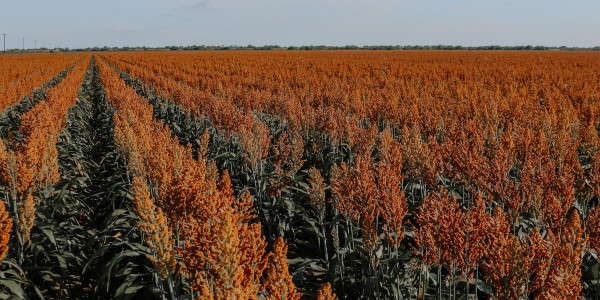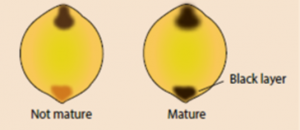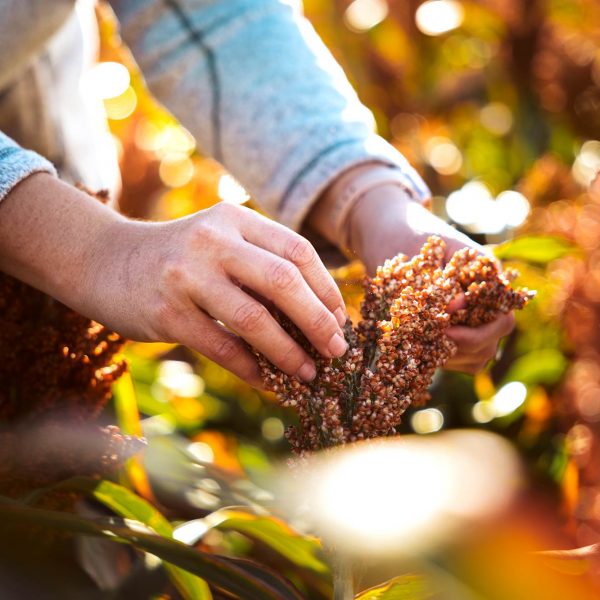
Harvest-Aid Use in Grain Sorghum
Brent Bean, United Sorghum Checkoff
Using a harvest-aid can help expedite the harvest allowing growers to get the grain out of the field and safely stored.
A harvest-aid will desiccate the green sorghum plants along with any weeds that may be present. It also prevents any late tillers from developing grain, which could further delay harvest or result in high-moisture grain being delivered to the elevator. Furthermore, by using a harvest-aid, grain sorghum can be harvested earlier, avoiding wet conditions that may lead to moldy grain or pre-harvest sprouting. Lastly, harvest efficiency can be improved, resulting in cleaner grain, especially when the sorghum heads are not sufficiently above the top leaves of the plant.
Three products that are labeled and commonly used as harvest-aids in grain sorghum: glyphosate, Aim® and sodium chlorate (Defol®).
- Glyphosate is the most commonly used product and kills the sorghum plants as well as many weeds. It works slowly but effectively in killing the plant, which means the stalk begins to deteriorate. If the sorghum is not harvested promptly after desiccation, lodging may occur. Therefore, when using glyphosate, treat only the number of acres that can be harvested within a few days of desiccation. The labeled pre-harvest interval is 7 days.
- Aim herbicide is sometimes mixed with glyphosate to enhance the control of morning glory and other vine-type weeds. The labeled pre-harvest interval is 3 days.
- Sodium chlorate is popular among growers who are producing sorghum for seed production, as there is no risk of the product moving into the seed and potentially hurting germination. Sodium chlorate acts quickly as a contact product, drying out the plant rather than killing it. If this product is used, growers should be prepared to harvest the crop swiftly, prior to any regrowth that may occur. Depending on the specific label, the pre-harvest interval is 7 to 10 days.
Apply a harvest-aid only after the grain has reached maturity. Grain matures from the top of the head and progresses downward, so check the bottom of the head for grain maturity. Be cautious not to apply a harvest-aid too early. Approximately 25 percent of the kernel’s seed weight is filled in the two weeks prior to reaching physiological maturity. The grain is considered mature once hard starch has formed at the base of the kernel where it is attached to the panicle branches. A mature kernel will have a black spot at its base.

At maturity, the grain contains between 25 and 30 percent moisture, and that is when a harvest-aid can be applied. A common misconception is that a harvest-aid speeds up the drying of the grain. This is not the case. Harvest-aids primarily dry out leaves and stalks but have very minimal impact on grain moisture. For this reason, most agronomists recommend waiting until the moisture content is below 20 percent before applying a harvest-aid. Grain drying time will depend on weather conditions.
Another consideration in using a harvest-aid in sorghum is the presence of sugarcane aphids. Harvest-aids used alone have not been shown to eliminate sugarcane aphids. If the sorghum plant is desiccated or killed, the sugarcane aphids eventually will leave. But, by that time, the window for a timely harvest may be past. If sugarcane aphids are present, it is best to apply an insecticide along with the harvest-aid to eliminate aphids and facilitate a timely and efficient harvest. Since sugarcane aphids only need to be controlled for a short period of time, use the lowest labeled rate of product.
For more information see the excellent publication from Dr. Josh Lofton at Ok-State: Using Harvest Aids in Grain Sorghum Production. A second article that provides additional information was prepared by Dr. Erick Larson at Mississippi State: When is it Safe to Apply a Harvest Aid in Sorghum.




